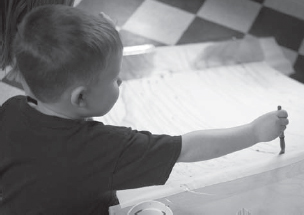![]()
Overview
Dribble painting is another deceptively simple activity that will lead to social interaction, conversation, experimentation, and learning—and all you’re doing is allowing kids to drip runny paint down a paper ramp.
![]()
The lack of unstructured play for youngsters is associated with less enthusiasm for learning, diminished creativity, and poorer social skills.
—Madeline Levine, Teach Your Children Well: Why Values and Coping Skills Matter More than Grades, Trophies, or “Fat Envelopes”
![]()
Ingredients

![]() butcher paper
butcher paper

![]() tape
tape

![]() paint
paint

![]() water
water

![]() paint cups
paint cups

![]() paintbrushes
paintbrushes



Process
1. Find a messy-play safe location and use tape and a sheet of butcher paper about 6 feet long to create a ramp. (This is something you probably shouldn’t do around your new tan suede sofa and white carpet.)
2. Squirt some paint into a paint cup and add water to dilute it. You’re looking for a nice runny consistency.
3. Use the paintbrushes to dribble the paint onto the upper edge of the paper ramp. Then step back and see what kind of play the kids bring to the materials.
More Play Adventures
• Use spray bottles. Apply color to the ramp with spray bottles.
• Guide it. Blow through drinking straws to guide the dribbles of paint down the paper ramp.
• Get in the gutter. Use a section of plastic rain gutter as a ramp. Because the pigment will not soak into the plastic, colors will mix as they move down the ramp.
• Adjust the grade. Play with the angle of your ramp: Steep ramps equal fast dribbles. Small inclines equal slow-moving dribbles.
• Dribble paint up the ramp. Plop some color at the bottom of the ramp and see if kids can use drinking straws, a blow-dryer (set on cool), or a fan to make the paint go up.
• Blow it up. While you have the blow-dryer out, why not try using cool air to push other objects up the paper ramp? Try things like bits of yarn, cotton balls, feathers, and aluminum-foil balls. The balloon pumps from chapter 13 work great for this variation too.
• Paint balls. Shake marbles or small balls in some paint, and then roll them down a paper ramp.
• Get dramatic. Set up a ramp in your dramatic play space, step back, and see how the kids choose to use it.
Turning to the next chapter is not a big project. Give it a try . . .